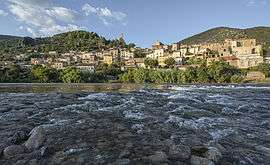Hérault
| Hérault | ||
|---|---|---|
| Department | ||
|
Prefecture building of the Hérault department, in Montpellier | ||
| ||
 Location of Hérault in France | ||
| Coordinates: 43°21′N 3°13′E / 43.350°N 3.217°ECoordinates: 43°21′N 3°13′E / 43.350°N 3.217°E | ||
| Country | France | |
| Region | Occitanie | |
| Prefecture | Montpellier | |
| Subprefectures |
Béziers Lodève | |
| Government | ||
| • President of the General Council | André Vezinhet (PS) | |
| Area1 | ||
| • Total | 6,101 km2 (2,356 sq mi) | |
| Population (2013) | ||
| • Total | 1,092,331 | |
| • Rank | 20st | |
| • Density | 180/km2 (460/sq mi) | |
| Time zone | CET (UTC+1) | |
| • Summer (DST) | CEST (UTC+2) | |
| Department number | 34 | |
| Arrondissements | 3 | |
| Cantons | 25 | |
| Communes | 343 | |
| ^1 French Land Register data, which exclude estuaries, and lakes, ponds, and glaciers larger than 1 km2 | ||
Hérault (French: [eʁo]; Occitan: Erau [eˈɾaw]) is a department in southern France named after the Hérault river. It is part of the Occitanie region of the country.
History
Hérault is one of the original 83 departments created during the French Revolution on 4 March 1790. It was created from part of the former province of Languedoc.
At the beginning of the 20th century, viticulture in the region was devastated by a slump in sales combined with disease affecting the vines, and thousands of small scale producers revolted. This revolt was suppressed very harshly by the government of Georges Clemenceau.
The catastrophic frost of the winter of 1956 damaged the olive trees, and the olive-growing regions did not recover until the late 1980s. Many of the olive-industry co-ops closed.
During the second half of the twentieth century the Montpellier basin underwent one of the most rapid population increases experienced anywhere in France.
Geography
Hérault is part of the current region of Occitanie and is surrounded by the departments of Aude, Tarn, Aveyron, Gard, and the Mediterranean (Gulf of Lion) on the south. The department is very geographically diverse, with beaches in the south, the Cévennes mountains in the north, and agricultural land in between.
The important rivers are:
The area of Hérault near the town of Lodève is an antipode point with Chatham Island, off the east coast of New Zealand.
Climate

The average daytime temperature is around 25-30 degrees Celsius in July and August and 8-10 degrees Celsius in December and January.
Politics
The President of the General Council is André Vézinhet of the Socialist Party.
| Party | seats | |
|---|---|---|
| • | Socialist Party | 20 |
| • | Miscellaneous Left | 14 |
| Union for a Popular Movement | 8 | |
| • | French Communist Party | 2 |
| National Front (France) | 6 | |
Demographics
The inhabitants of the department are called Héraultais.
Culture
Montpellier hosts the following festivals:
- Saperlipopette, voilà Enfantillages !
- Printemps des Comédiens
- Festival du Cinéma Méditerranéen
- Comédie du Livre
- Festival Radio-France Montpellier
- Festival Montpellier Danse
The Canal du Midi has been designated as a World Heritage Site by UNESCO.
Tourism
The Mediterranean beaches are a major attraction, as well as the caves of Clamouse and Demoiselles.
Pézenas, former Royal city, has one of the oldest French "secteur sauvegardé", meaning an urban protected area. More than 30 mansions, with stone stairs, courtyards, decorated facades are located in a small perimeter (17 ha).
Part of Cap d'Agde is a major nudist resort.
Cruising along the Canal du Midi and walking or cycling along the tow paths is a popular holiday option.
 Agde, Hérault, France
Agde, Hérault, France Canal de la Peyrade
Canal de la Peyrade


 Kayaking on the Hérault River
Kayaking on the Hérault River
See also
- Cantons of the Hérault department
- Communes of the Hérault department
- Arrondissements of the Hérault department
- Castles in Hérault
External links
| Wikivoyage has a travel guide for Hérault. |
| Wikimedia Commons has media related to Hérault. |
- (French) Prefecture website
- (French) Conseil Général website
- (English) The Hérault Tourist Board
- (English) Canal du Midi
- (English) Official tourist office website for Béziers
- "A Force in Gaul", in On Something by Hilaire Belloc (1910).

